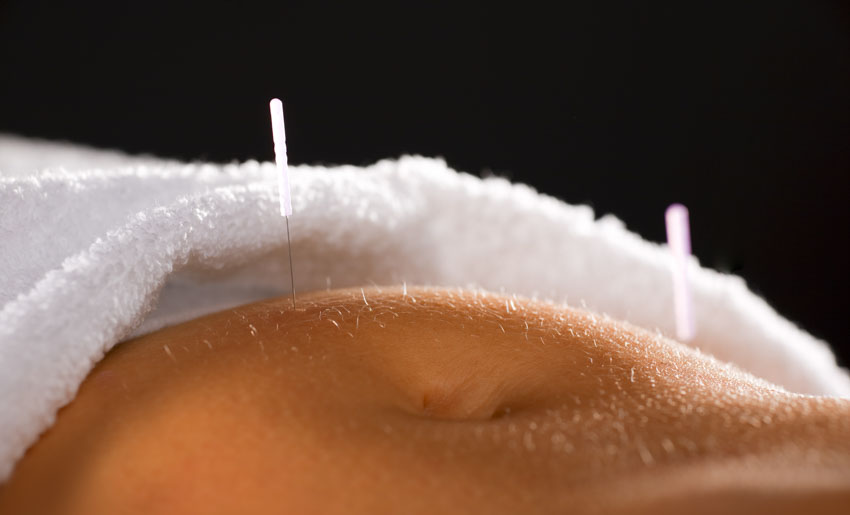
Acupuncture improves IVF (in vitro fertilization) outcomes. Warm needle acupuncture reduces ECF (endometrial cavity fluid) accumulation and improves clinical pregnancy rates following IVF. These are the findings of a study conducted at Foshan Women and Children’s Hospital (Guangdong, China). [i]
Increased ECF is associated with poor implantation rates following in vitro fertilization-embryo transfer (IVF-ET). The highest implantation rates occur with ECF diameters of <2 mm. [ii] This study compared the effectiveness of warm needle acupuncture with Chinese herbal medicine (Yi Mu Cao, Herba Leonuri, capsules) in 29 women whose IVF embryo transfers had been delayed due to increased ECF. As well as reductions in ECF diameter, the study’s outcomes included the time taken to embryo transfer and clinical pregnancy rates. The acupuncture group experienced significantly better outcomes across all measures and had a pregnancy rate of 42.9% compared with 26.7% in the herbal medicine control group.
Twenty-nine women were assigned to the acupuncture group or the herbal medicine control group by random number table method. The acupuncture group was comprised of 14 women, ages 27–38 (mean age 32), that had been trying to conceive for 1–4 years (mean time 2.5 years) and previously underwent a mean 2.5 embryo transfers. The herbal medicine control group was comprised of 15 women, ages 26–37 (mean age 31), that had been trying to conceive for 1–5 years (mean time 2.6 years) and previously underwent a mean 2.6 embryo transfers. There were no statistically significant differences in baseline characteristics between the two groups after randomization.
Inclusion criteria for the study were as follows: currently undergoing IVF treatment, preparing for frozen embryo transfer with the current cycle having been canceled due to increased ECF, ages 22–40, no uterine echo revealed by ultrasound, informed consent. Exclusion criteria were as follows: normal uterine analysis, physical abnormalities of the uterus, endometrial abnormalities or disorders, uterine nodules or adhesions, use of hormonal contraceptives in the previous three months, long-term use of NSAIDs (non-steroidal anti-inflammatory drugs), chronic conditions such as hypertension or diabetes, psychiatric disorders.
Acupuncture Sessions
The observation group was treated with warm acupuncture administered at the following acupoints:
- Zhongwan (CV12)
- Qihai (CV6)
- Guanyuan (CV4)
- Zhongji (CV3)
- Guilai (ST29)
- Zigong (MCA18)
- Zusanli (ST36)
- Sanyinjiao (SP6)
Treatment began at the end of the menstrual period and continued until embryo transfer. With the patient in a supine position, the acupoints were disinfected and single-use, 0.35 x 50 mm needles were selected. Needles were inserted perpendicularly into the abdominal points using a skin-spreading technique, to a depth of 15–20 mm. After eliciting deqi, the needles were manipulated using a lifting-thrusting, balanced reinforcing-reducing method to extend needle sensation across the abdomen.
Needles were inserted perpendicularly into the lower leg points to a depth of 10–15 mm. After eliciting deqi, the needles were manipulated using a twisting-rotating, balanced reinforcing-reducing technique to extend needles sensation to the far ends of the limbs. Exposed skin was covered with two layers of protective paper, and a 20 mm piece of moxa roll was attached to the needle handles. The moxa was ignited and allowed to burn to ash before replacement. Warm needle acupuncture was continued for one hour each time. Treatment was administered daily, with five treatments making up each course. A total of three courses were administered with a two-day break between courses of patient care.
The control group was treated with Yi Mu Cao oral capsules, 0.8 grams, three times a day. One week of treatment made up one course, and a total of three consecutive courses were administered. As with the acupuncture group, treatment began at the end of the menstrual period and continued until embryo transfer.
Outcomes and Discussion
Outcome measures included APD (anterior-posterior diameter) changes in uterine effusion volume, time to embryo transfer, and clinical pregnancy rate. APD was measured at the beginning of the study and again after each course of treatment. Mean pre-treatment APD was 4.9 mm in the acupuncture group and 5.1 mm in the control group. After one course of treatment, mean APDs reduced to 2.5 mm and 3.6 mm, respectively. After two courses, they reduced further to 0.5 mm and 2.3 mm, and after three courses, they reduced further to 0 mm and 1.5 mm. Significantly greater reductions in APD were observed in the acupuncture group at all three post-treatment datapoints. Time taken to embryo transfer was significantly shorter in the acupuncture group, with a mean time of 10.8 days compared with 36.5 days in the control group.
Clinical pregnancy was confirmed by HCG (human chorionic gonadotropin) tests at 14 days after embryo transfer, and ultrasound at 28–35 days after embryo transfer. There were no statistically significant differences in the number of high-quality embryos transferred, with 2.2 transferred in the acupuncture group compared with 2.1 in the control group. However, the pregnancy rate was higher in the acupuncture group, with 6 women (42.9%) becoming pregnant, compared with 4 (26.7%) in the control group. A main limitation of this study is the sample size and a larger multi-arm study with strict controls will help to confirm the results.
The results of this study indicate that warm needle acupuncture improves outcomes of IVF in women whose embryo transfers have been delayed due to increased ECF. Acupuncture has the potential to reduce ECF and the time taken to embryo transfer, as well as increasing clinical pregnancy rates.
References:
[i] Su Wenwu, Gao Xiuan, Gao Zhiyun, Pan Jialei, Deng Fang, He Wanting (2019) “Clinical observation on the therapeutic effect of warm acupuncture on endometrial cavity fluid from in vitro fertilization embryo transfer” Chinese Acupuncture and Moxibustion. Vol.39(9) pp.923-926.
[ii] Nitika Gupta, Shilpa Bhandari, Pallavi Aggarwal, Ishita Ganguly, Aparna Singh (2017) “Effect of Endometrial Cavity Fluid on Pregnancy Rate of Fresh vs. Frozen In Vitro Fertilization Cycle” Journal of Human Reproductive Sciences. Vol.10(4) pp.288-292.


